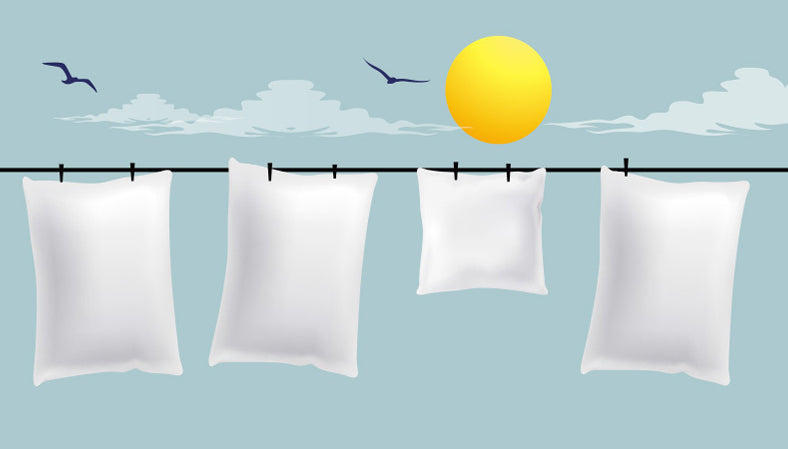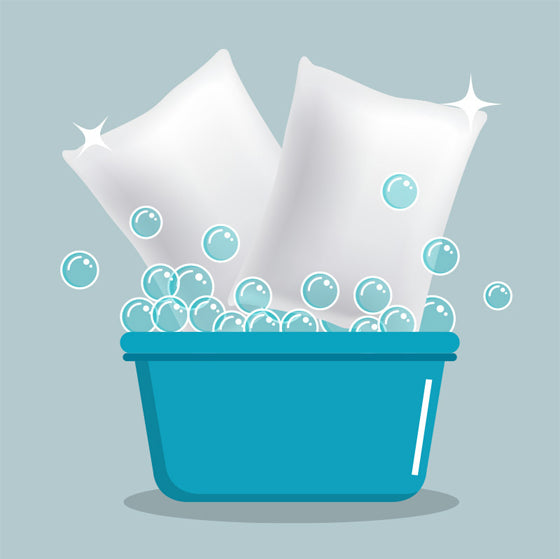No Products in the Cart
Zulekha Nishad, based in India, is a skilled content specialist, copy editor, and creative content writer with a Master's degree in English Language and Literature. Read more
Last Updated April 16, 2025
Do you know how to keep your pillows fresh and clean? If not, don't worry - we're here to help! In this blog post, we'll share some tips for taking care of your pillows. So whether your pillows are old and stained or you just want to make sure they stay in good condition, read on for the best pillow care tips.

You might not think about it often, but your pillow is one of the dirtiest items in your home. After all, it's something you rest your head on for hours every night, and over time, it collects dust, skin cells, and even Bugs. Yes, Bugs. Dust mites, to be exact. These tiny creatures are too small to see with the naked eye, but they thrive in warm, humid environments - like your pillow.
In fact, 10% of the weight of a 2-year-old pillow includes dead mites and their droppings! Unbelievable, right? And if you have allergies, those pillow-dwelling critters can wreak havoc on your sinuses. The good news is that pillow care is easy.
Most people don't think twice about pillow care. They just plop their pillow on the bed and hope for the best. But if you want your pillow to last, you need to take a few simple steps to keep it clean and fresh. Here's how to wash pillows the right way:
Giving your pillows a daily fluff is the best way to keep them looking and feeling their best. This simple task helps to restore their shape and remove dust. For an extra deep clean, hang them outdoors on a clothesline (away from the sunlight, if possible) for a few hours every month or so. If you can't hang them outside, running them through the dryer on the no-heat cycle is a good alternative.

You should wash your pillow at least every 4 to 6 months. If you sweat a lot, have a habit of eating in bed, or have pets with whom you share your bed, you should wash it more often. Washing a pillow is not difficult, but it does take some time to dry.
If there is a wet stain on your pillow that you want to get rid of, spot clean it with the help of a stain remover before popping them into the washing machine.

To spot clean your pillow, dampen a clean cotton cloth, preferably white, with water and a little amount of mild detergent. Rub the part of the pillow that needs to be cleaned lightly. While rubbing, make sure to press into the pillow material gently to penetrate the stain. Also, if there's any lint or hairs on the pillow, you can pull it off using a handheld vacuum cleaner.
Most pillows are machine washable, just like your regular laundry. However, make sure you read the pillow care label first to see if it is okay to machine wash.
Here's how to wash your pillows in a washing machine:
1. Add lukewarm water and choose the gentle cycle
2. After that, add some mild detergent
3. Now, add some cold water and choose the rinse and spin cycle option
4. Finally, tumble your pillows dry on low heat
If your washing machine is big enough, you can wash two pillows at the same time. This will help the water and detergent move around better, thus balancing the load. But be careful with top-loaders because the agitator can damage pillows. So, it's best to just use the gentle cycle for a few minutes.
Since washer agitation can break up the foam in latex pillows, they cannot be machine washed and probably need spot cleaning.
First, use a handheld vacuum to dust off the pillow. After that, spot clean using a damp cotton cloth and a small amount of mild detergent. Finally, place your pillow flat to air dry it.

Most down or feather pillows can be put in the washing machine. When you wash them, use cool water and a mild detergent. Finally, dry the pillow.
High temperatures can damage the down or feather, so make sure you dry on low heat.
Like latex, you cannot machine wash memory foam pillows. So, it is better to hand wash them.
To hand-wash a memory foam pillow, first use a vacuum cleaner to remove the dust and small particles. After that spot treat it with a damp cloth and make sure you use a mild detergent while cleaning. Now place your pillow flat to dry.
You can machine wash polyester pillows using warm water on a gentle cycle. Be liberal with the detergent—go for 1 tablespoon of mild liquid detergent. Polyester pillows can also be hand-washed if needed.

Once you complete the washing process, get your pillow completely dry—otherwise, you risk mildew.
Latex pillows: Air-dry your latex pillows. The UV rays from the sun can damage the latex foam, causing it to break down over time. So make sure you air-dry them away from direct sunlight.
Memory foam pillows: Like latex, you can also air-dry a memory foam pillow. Even if you don't get time to wash them, just drying them out under direct sunlight for a few hours will keep them fresh. The high temperature of the sun's rays wards off dust mites and other allergens, making your memory foam pillows germ-free.
Feather or down pillows: You can dry these types of pillows in your dryer on the no-heat air-dry setting. Or you can also let them air-dry naturally.
Polyester pillows: Compared to other pillow types, polyester pillows dry fast. You can either air-dry them or put them in your dryer in a low heat setting.
Put two fresh tennis balls (or tennis balls in socks) inside the dryer with the pillows. This will help reduce clumping. The tennis balls will bounce around and break up the clumps inside the pillows.
Yes, there are some types of special pillow fillings you should not wash. This includes buckwheat and kapok pillows. But if you are using them, you don't have to worry at all. You can just take out the filling and wash the outer cover to keep it fresh and clean.
Don't wash the buckwheat hulls in a buckwheat pillow. Just wash the cover. If the hulls get wet, they will not work as filling. You can put the hulls in a plastic bag while you wash and dry the cover. Yes, you may feel that it's going to be a mess, but it is worth it if you need a clean pillow.

Like buckwheat, pillows with kapok fillings are not meant for washing. They have removable covers that can be washed separately. Or, kapok pillows can also be spot-cleaned using detergents like baking soda.

If your pillow gets dirty, you should wash it right away. If it's not too gross, try to wash it every 4 to 6 months.
It's also a pretty good idea to air out or fluff your pillow occasionally. You can do this by throwing it in the dryer for a few minutes or leaving it outside overnight.
Just like you have to replace your mattress after years of use, you will also need to replace your pillow at some point.
Some sleep and allergy specialists recommend buying new pillows every two to three years. This is because pillows collect allergens, dust mites, and, yes, dead skin - that's what makes them get heavier over time. However, purchasing an anti-allergy pillow cover can improve the life of your pillow to a great extent./p>
Even if you wash your pillows regularly, or every 4 to 6 months, you will have to replace them periodically. Yes, washing and regular cleaning might prolong their lives, but they won't make your pillows last a lifetime.
A good time to replace your pillow is when it stops providing enough support and comfort to your head and neck. Another way to find out if your pillow is ready to be replaced is to fold it in half. If it doesn't spring back into its original shape, it might be high time for a new one.

Pillowcases help absorb sweat and dust that accumulate on the surface of the pillow. This increases the amount of time between washes as well as extends the overall life of the pillow. At Turmerry, we recommend washing your pillowcases every week.
Invest in a pillow protector - a special cloth that offers added protection. It is usually placed between the pillow and the standard pillowcase.
Pillow protectors block absorption, and this is especially good for allergy sufferers. However, you should wash them on a regular basis, along with other clothes.
Proper pillow care can do wonders for your sleep, which affects your energy levels, stress levels, productivity, and much more. Take care of yourself by taking care of your pillows, but remember to always check the label and the manufacturer's guidelines first.
If you're still doubtful and think that a little bit of dirt can do no harm, just think about all the dead skin cells, dust mites, and other allergens that accumulate on your pillow. Not only is it unhygienic to sleep on dirty pillows night after night, but it can also lead to irritation and allergies. So before you hit the hay tonight, make sure to give those pillows a good wash!
Related blog posts:
2. Your Guide to Buying the Perfect Pillow Case Sizes
5. How to Choose The Right Pillow
Disclaimer: What is said in this article has been referenced from multiple sources and is intended only for educational and informational purposes. Please note that no content in this article is a substitute for professional advice from a qualified doctor or healthcare provider. Always consult an experienced doctor with any concerns you may have regarding a health condition or treatment, and never disregard any medical suggestions or delay in seeking treatment because of something you read here.
Notify me when available
We will send you a notification as soon as this product is available again.
We don't share your email with anybody


